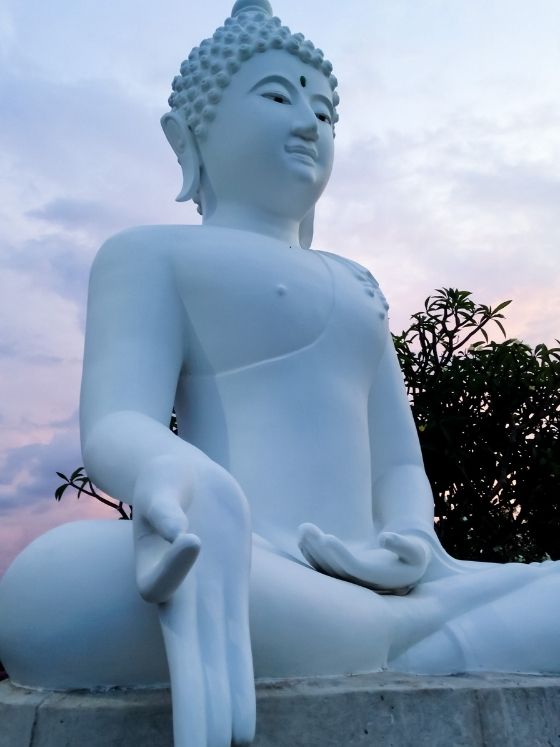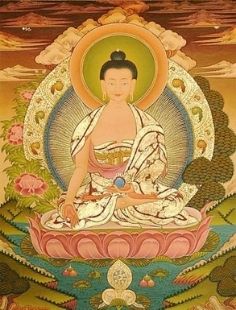Varada Mudra (Boon Dispenser Gesture): Meaning, How to Do & Benefits
Varada Mudra, also known as the “Boon Dispenser Gesture” or “Favorable Mudra,” is an important hand gesture in Hinduism, Jainism, and Buddhism. This ancient gesture is often depicted in statues of gods and spiritual figures from these religions. It...

 Image Source: Canva
Image Source: CanvaVarada Mudra, also known as the “Boon Dispenser Gesture” or “Favorable Mudra,” is an important hand gesture in Hinduism, Jainism, and Buddhism. This ancient gesture is often depicted in statues of gods and spiritual figures from these religions. It symbolizes the act of granting blessings and fulfilling the wishes of people. Frequently seen in statues and spiritual art, Varada Mudra is a key symbol of divine generosity and compassion.
In this article, we will explore the meaning of Varada Mudra, its role in different religions, and how to perform it effectively.
Meaning
The term “Varada” comes from the Sanskrit word meaning “granting of wishes” or “boons,” and “mudra” means “hand gesture” or “seal.” Varada Mudra is shown by an open hand with fingers pointing downward, symbolizing the act of giving. This gesture shows a willingness to offer blessings and fulfill desires, and it represents qualities like generosity, compassion, and sincerity. In religious contexts, it symbolizes the deity’s ability to grant favours and help those who sincerely ask for it.
Symbolic representation
Symbolically, Varada Mudra represents a gesture of giving and forgiving.
Those with open hearts always have open hands.
~ Rumi
Just as an open heart and open hands are connected, Varada Mudra links the concepts of giving and forgiving. This combination of giving and forgiving can lead to blessings for the practitioner.
The five extended fingers in Varada Mudra represent five key virtues:
Generosity Morality Patience Effort Meditative concentrationReligious significance
Along with being a meditative hasta mudra, there are various religious beliefs and significance associated with Varada mudra. It is seen as iconography or in statues of deities of Hinduism, Buddhism, and Jainism.
References in Hindu Mythology
In Hindu mythology, Varada Mudra is often shown in statues of Lord Vishnu. This hand gesture means he is giving blessings and helping his followers. When used with Abhaya Mudra, it shows Vishnu and his wife, Shri Lakshmi, providing protection and support.
According to tradition, Shridevi (another form of Lakshmi) promises to give people what they need when they use this mudra. She is believed to say:
Don’t worry, I will give you the boons for your material enjoyment!
~ Shri Lakshmi
The importance of Varada Mudra is mentioned in old Hindu texts like the Pancaratra, Shilpashastra, Padmasaṃhitā, and Vaikhanasa-agamas.
In Buddhist Religion
In Buddhism, monks and other practitioners use Varada Mudra in spiritual rituals and exercises to enhance concentration. It is commonly featured in Buddha statues from Southeast Asia, making it one of the well-known Buddha mudras.
In India, Varada Mudra is also depicted in images of Bodhisattva Avalokitesvara from the Gupta period, which dates back to the 4th or 5th centuries.
 Ratnasambhava in varada mudra.
Ratnasambhava in varada mudra. Image Source: buddhism.redzambala.com
Another important Buddhist figure often depicted holding Varada Mudra is Ratnasambhava. In Vajrayana Buddhism, Ratnasambhava is one of the five Dhyani Buddhas. He is shown with Varada Mudra in his right hand, while his left hand rests on his lap, holding a shining jewel. This symbolizes Bodhichitta, which represents the highest value in Buddhism.
Varada Mudra is believed to unlock the wisdom of equality and help prevent the delusion of pride.
Practicing this mudra during meditation can lead to a prosperous and fulfilled life, bringing a shower of blessings.
How to do Varada mudra(steps)
Sit comfortably in a meditative posture such as Sukhasana (Easy Pose), Padmasana (Lotus Pose), or Swastikasana (Auspicious Pose)/ Keep your spine and neck erect. Rest both palms on your knees, with the palms facing upwards. Extend your right hand downward with fingers pointing to the ground. Relax your left hand on your lap or knee. Maintain a gentle breath, inhaling and exhaling slowly. Focus on your inner self and witness your thoughts and feelings. Practice this mudra regularly during your meditation sessions for the best results.Also Read: Abhaya Mudra (Gesture of Fearlessness)
Time & Duration
Ideal Time: Practice Varada Mudra in the morning between 4 am and 6 am for the best results. This is when the mind is most alert and focused. Duration: Aim for 10-20 minutes daily. You can do this in one stretch or in shorter sessions throughout the day. Consistency is key to gaining the benefits of the mudra.Precautions
Be gentle with your fingers and hands to avoid strain or injury. Maintain an erect spine to prevent back discomfort. Start with short practice sessions and gradually increase the duration as you become more comfortable.Side effects
Varada Mudra has no known side effects and is generally safe to practice. If you experience any discomfort, adjust your posture or consult a yoga professional.
Varada Mudra and abhaya Mudra
Varada Mudra is often practiced alongside Abhaya Mudra, the gesture of fearlessness. Visually, Abhaya Mudra is the exact opposite of Varada Mudra, with the palm open and fingers extended upward.
Combination aspect
Varada Mudra represents the divine ability to fulfill the believer’s material desires.
While it is natural for individuals to seek material pleasure, the experience of liberation in the afterlife is considered more important than earthly possessions.
Typically, the right hand is more actively used, which is why the significant gesture of Abhaya Mudra (symbolizing protection and fearlessness) is performed with the right hand, while Varada Mudra is performed with the left.
In Japan, practicing Varada Mudra along with Abhaya Mudra is known as Segan Semui-in or Yogan Semui-in.
Benefits of varada mudra
Cultivates positive attitudes such as generosity, patience, and morality Empowers forgiveness and aligns with Buddhist teachings Brings sincerity and compassion into life Fulfills wishes and promotes positivity Enhances concentration and mental clarity Calms the mind and alleviates anxieties related to wealth and material concernsConclusion
Varada Mudra is more than a hand gesture; it is a symbolic practice that embodies the spirit of generosity and blessing. Whether in meditation or daily life, this mudra encourages a compassionate and giving nature, helping practitioners connect with their spiritual aspirations and fulfill their deepest desires.

 Tekef
Tekef 
































